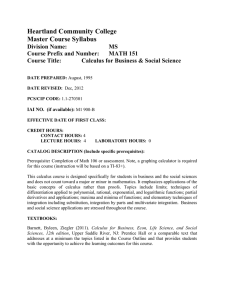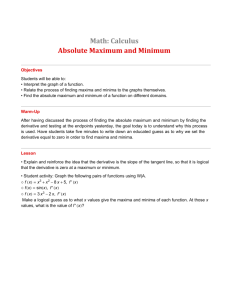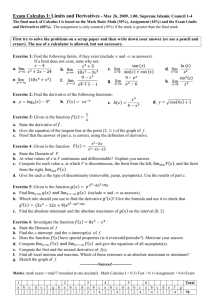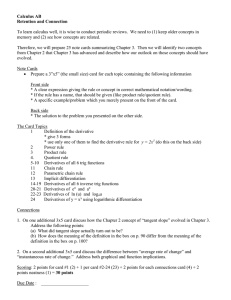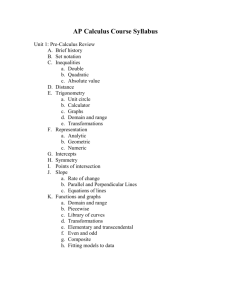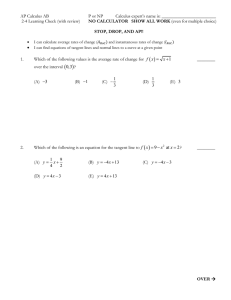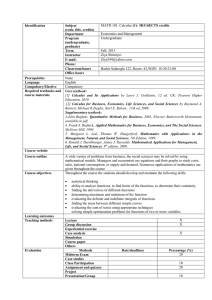MATH151_2015-01 - Heartland Community College
advertisement
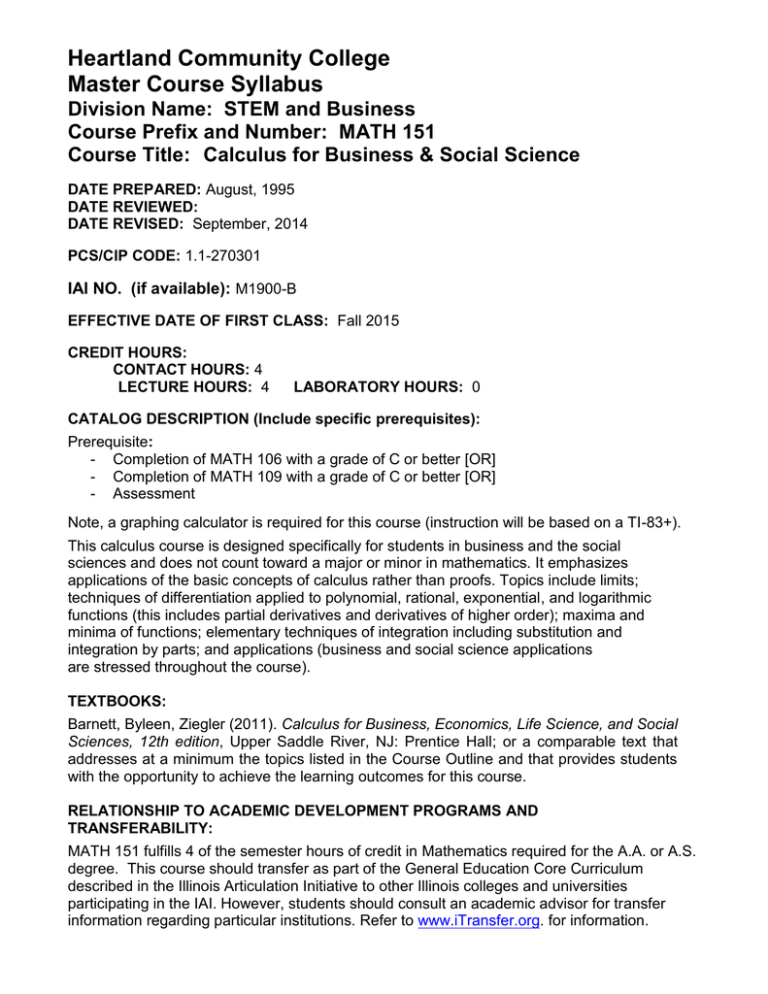
Heartland Community College Master Course Syllabus Division Name: STEM and Business Course Prefix and Number: MATH 151 Course Title: Calculus for Business & Social Science DATE PREPARED: August, 1995 DATE REVIEWED: DATE REVISED: September, 2014 PCS/CIP CODE: 1.1-270301 IAI NO. (if available): M1900-B EFFECTIVE DATE OF FIRST CLASS: Fall 2015 CREDIT HOURS: CONTACT HOURS: 4 LECTURE HOURS: 4 LABORATORY HOURS: 0 CATALOG DESCRIPTION (Include specific prerequisites): Prerequisite: - Completion of MATH 106 with a grade of C or better [OR] - Completion of MATH 109 with a grade of C or better [OR] - Assessment Note, a graphing calculator is required for this course (instruction will be based on a TI-83+). This calculus course is designed specifically for students in business and the social sciences and does not count toward a major or minor in mathematics. It emphasizes applications of the basic concepts of calculus rather than proofs. Topics include limits; techniques of differentiation applied to polynomial, rational, exponential, and logarithmic functions (this includes partial derivatives and derivatives of higher order); maxima and minima of functions; elementary techniques of integration including substitution and integration by parts; and applications (business and social science applications are stressed throughout the course). TEXTBOOKS: Barnett, Byleen, Ziegler (2011). Calculus for Business, Economics, Life Science, and Social Sciences, 12th edition, Upper Saddle River, NJ: Prentice Hall; or a comparable text that addresses at a minimum the topics listed in the Course Outline and that provides students with the opportunity to achieve the learning outcomes for this course. RELATIONSHIP TO ACADEMIC DEVELOPMENT PROGRAMS AND TRANSFERABILITY: MATH 151 fulfills 4 of the semester hours of credit in Mathematics required for the A.A. or A.S. degree. This course should transfer as part of the General Education Core Curriculum described in the Illinois Articulation Initiative to other Illinois colleges and universities participating in the IAI. However, students should consult an academic advisor for transfer information regarding particular institutions. Refer to www.iTransfer.org. for information. LEARNING OUTCOMES: Course Outcomes Essential Competencies Interpret graphs of functions. Recognize, graph, and formulate linear, power, polynomial, rational, exponential, and logarithmic functions. Perform basic operations (addition, subtraction, multiplication, and division) on functions and express a function as a composition of two functions. Apply the interest formulas for compound and continuously compounded interest to determine the value of the investment, length of time of investment, etc. Define the average rate of change. Know the relationship between average rate of change and the slope of the secant line. Evaluate limits of functions. Define the derivative. Know the relationship between the derivative, the instantaneous rate of change and the slope of the tangent line. Describe the relationship between the tangent line to the curve of a function and the derivative of the function. Apply appropriate method(s) of Calculus to determine the equation of the tangent line to the curve of a function at a particular point. Apply basic rules of differentiation, including the chain rule, to determine the derivatives. Determine higher order derivatives. Use derivatives to determine intervals for which a function is increasing or decreasing, and concave up or concave down, points of local maxima and minima, and points of inflection; then sketch the graph of a function. Apply techniques of integration (including substitution and by parts) to determine indefinite integrals. Use Riemann sums to estimate definite integrals. Apply appropriate method(s) of Calculus to determine the area bounded by the curves of functions. Apply the Fundamental Theorem of Calculus to determine the value of a function at a particular input value. Evaluate and interpret multivariable functions. Determine and interpret partial derivatives. Determine the extrema of a multivariable function. Apply Lagrange Multipliers to determine the maxima and minima of a multivariable function subject to a given constraint. Apply calculus to solve practical problems such as maximizing profits, minimizing costs, determining marginal cost and revenue, determining consumer and producer’s surplus, determining the present and future values of an income stream, etc. Interpret the derivative and definite integral for these applications. Range of Assessment Methods Assessments will include exams, and may include but not limited to homework, quizzes, and projects. CT 2 PS 4 CO 2 CT 2: Students determine value of multiple sources or strategies and select those most appropriate in a given context. Students compare various perspectives, strategies or concepts and respond using the most appropriate alternative. CO 2: Students effectively deliver a message via various channels/modalities. Students prepare written, oral, visual, and/or experiential materials for an area of study. PS 4: Students analyze the situation, explore different outcomes from multiple frameworks, apply the appropriate solution, analyze the results, and refine the solution. Students see problem solving as a process and are not satisfied with the first answer to a problem – review answers for validity. Students transfer problem solving ability across the disciplines. COURSE/LAB OUTLINE: 1. 2. 3. 4. 5. 6. 7. 8. 9. Functions and their graphs The derivative Techniques of differentiation Applications and interpretations of the derivative The definite and indefinite integral Techniques of integration Curve sketching Applications and interpretations of the definite integral Multivariable Calculus METHOD OF EVALUATION (Tests/Exams, Grading System): Instructors may determine the most appropriate methods of evaluation for their course. These methods of evaluation will include unit tests and a comprehensive final exam, and may include but not limited to homework, quizzes, and projects. GRADING SCALE: S.P.: Student Performance 90 S.P. 100 A 80 S.P. 90 B 70 S.P. 80 C 60 S.P. 70 D 00 S.P. 60 F REQUIRED WRITING AND READING: Students are expected to read the material in the textbook for each section studied, which is approximately 650 pages for the semester. Required writing will be part of most activities. Students are expected to explain solution processes, describe solutions analytically and graphically, and interpret the answer in the context of the problem. Instructors may incorporate writing assignments as part of the course grade, in keeping with learning outcomes. Other reading assignments may be assigned, possibly in conjunction with writing assignments.
